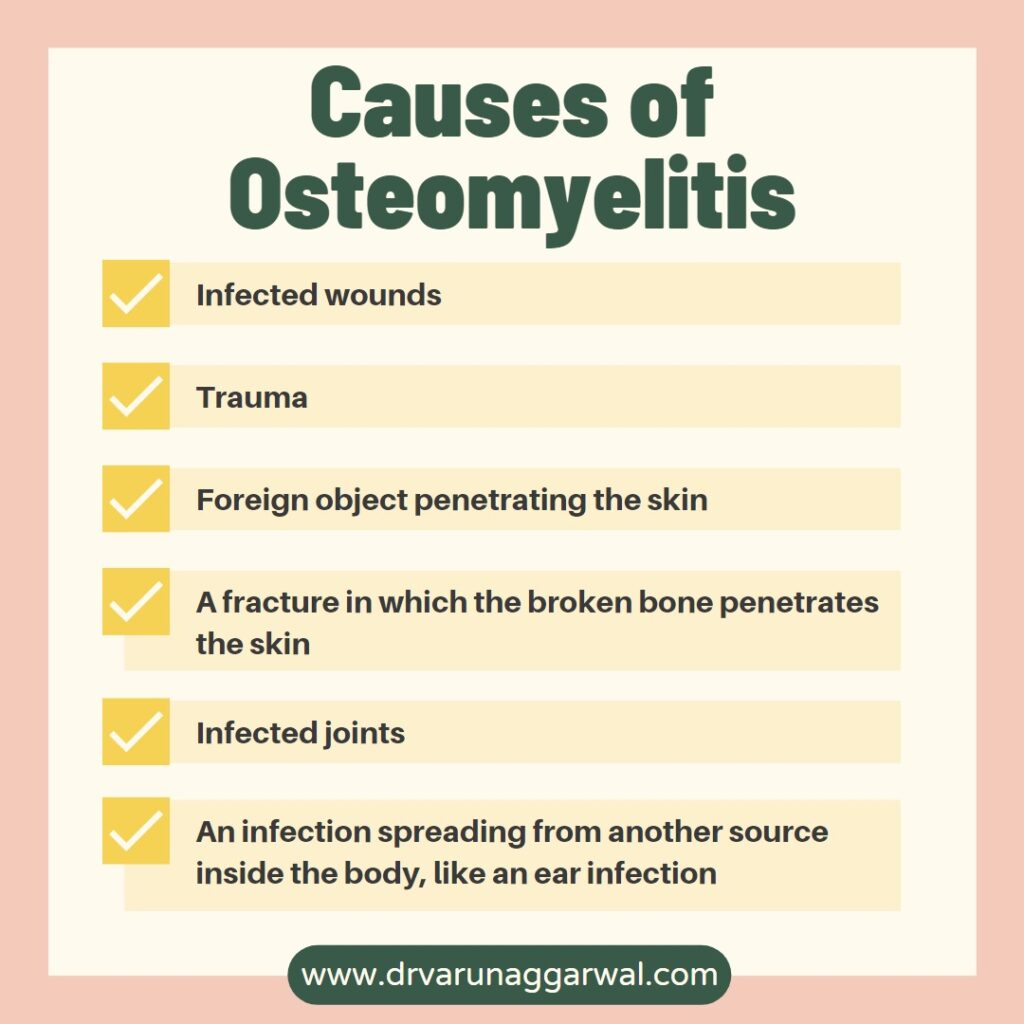Bacteria can enter the body through the musculoskeletal system and cause infection. These infections of the bones and joints are also known as musculoskeletal infections that most commonly occur in toddlers and young children. Musculoskeletal infections usually affect the joints and bones in the arms and legs.
Causes of Osteomyelitis
Osteomyelitis is caused by many different types of bacteria. Staphylococcus aureus is the most common type of bacteria that causes bone infections in children. Fungi can also cause Osteomyelitis. There are numerous routes for bacteria and fungi to enter the body, including but not restricted to:
- Infected wounds
- Trauma
- Foreign object penetrating the skin
- A fracture in which the broken bone penetrates the skin
- Infected joints
- An infection spreading from another source inside the body, like an ear infection
Symptoms of Osteomyelitis in children
Each child may experience different symptoms but the
The most common signs and symptoms of osteomyelitis are as follows:
- Pain or tenderness in the infected area
- A child may be able to use the infected extremity only to a limited extent or may not even be able to use it at all.
- Swelling in the infected area
- Fever
- When this area is touched or shown, the child usually guards it or protects it.
- Redness in the infected area
- Warmth surrounding the infected region
If osteomyelitis is suspected, prompt medical attention should be sought. The symptoms of osteomyelitis can be similar to those of other diseases or disorders.
Diagnosis of Bone Infections
The following tests are used by doctors to identify infections in childrens with the above symptoms:
Physical exam: Doctors utilise this routine test to evaluate patient health.
Blood test: This test analyses a sample of blood.
X-ray: It helps identify possible infection sites inside the body by producing images.
Magnetic resonance imaging (MRI): The test produces images of areas of the body that are infected to determine if they are inflamed.
Computed tomography (CT): Cross-sectional images of the body are obtained by this special X-ray to determine if certain parts of the body are infected.
How is osteomyelitis treated?
Initially, patients are treated in hospitals. The procedure might involve:
- antibiotic or antifungal medications, given through an IV (intravenous) line or by mouth (oral)
- Pain medicine
- Operation to clean the infected area from the bone.
Antibiotics may be administered to your child for 4 to 6 weeks. A PICC line (peripherally inserted central catheter) can be used to perform this at home. In other cases, your child may be able to take oral antibiotics. This will depend on how they have responded and the specific germ causing the infection.
How to prevent bone infections in children?

Keeping skin clean is one approach to prevent osteomyelitis. All cuts and wounds should be thoroughly cleaned, especially deep wounds. Wash the wound with soap and water by keeping it submerged in running water for at least five minutes.
Cover the wound with sterile gauze or a clean cloth to keep it clean afterward. You can also use an over-the-counter antibiotic cream, but maintaining cleanliness is the most important thing. The wound will begin healing within 24 hours and be completely healed within a week.
A doctor should be consulted if a wound is extremely painful or takes a long time to heal. Dr Varun Aggarwal is the leading Orthopaedic Specialist in Chandigarh who handles such cases very well.
Parents and children should wash their hands thoroughly and frequently to prevent the spread of germs, as is the case with many diseases. Children’s vaccination should also be up to date.
Click here to contact for more information


